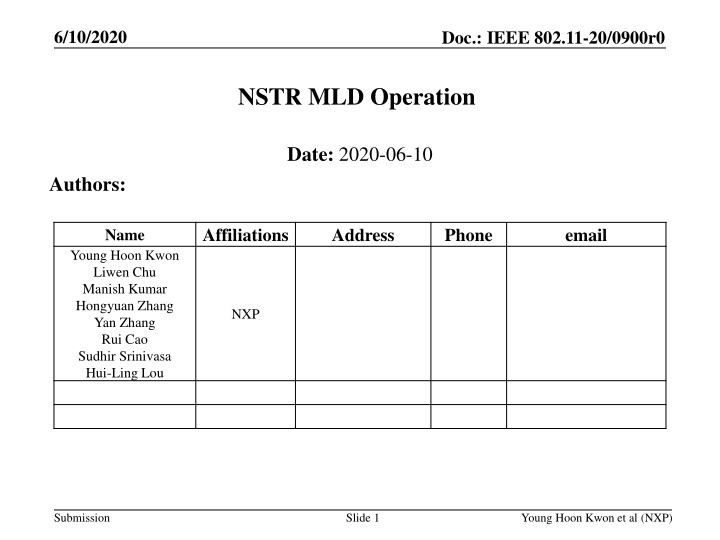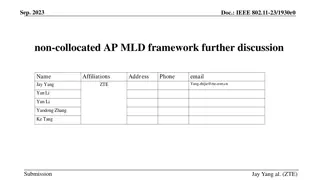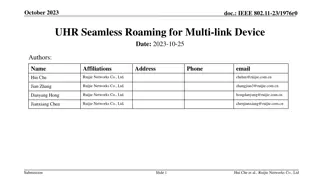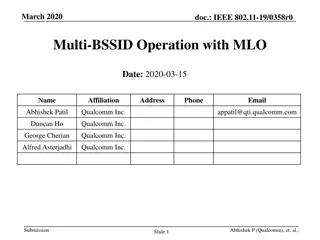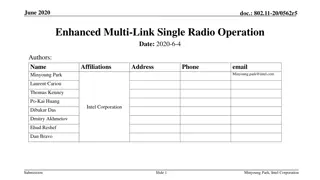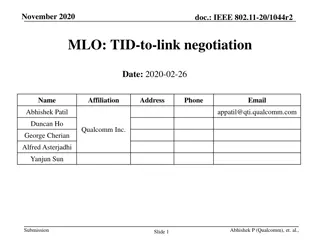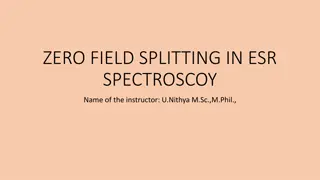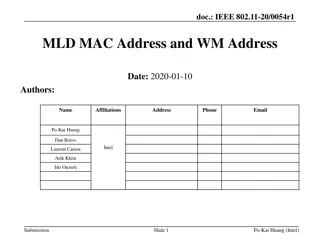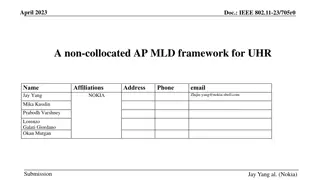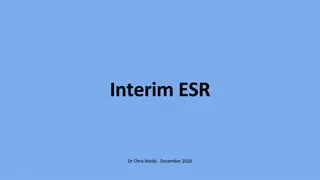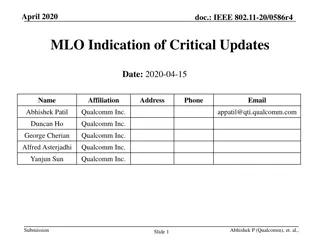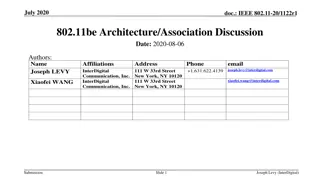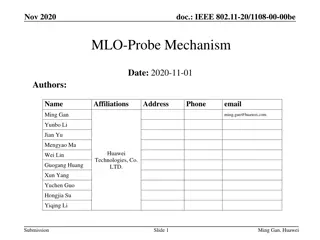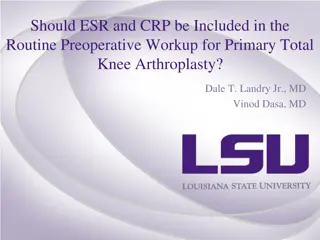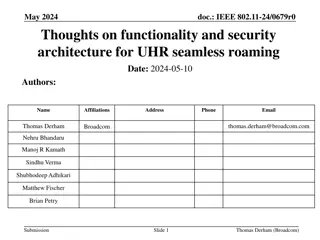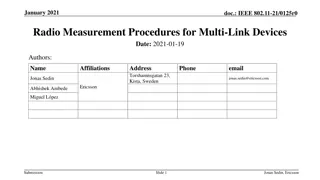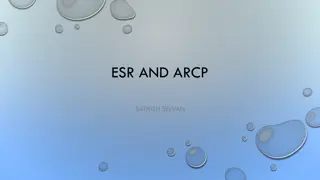Enhancing Network Performance with NSTR MLD and SR/eSR MLDs
This document discusses the performance characteristics of Multi-Radio MLD (NSTR MLD) and Single-Radio/Enhanced Single-Radio MLDs (SR/eSR MLDs) in various operation scenarios. It highlights the strengths and weaknesses of NSTR MLDs and proposes ways to improve their operation efficiency. Additionally, it suggests utilizing SR/eSR MLDs as a complement where NSTR MLDs do not show performance gains, emphasizing the need for optimized power management and resource allocation for better throughput and latency. The proposal introduces a mode where NSTR MLD can operate as SR/eSR MLD to leverage different physical layer capabilities effectively.
Download Presentation

Please find below an Image/Link to download the presentation.
The content on the website is provided AS IS for your information and personal use only. It may not be sold, licensed, or shared on other websites without obtaining consent from the author.If you encounter any issues during the download, it is possible that the publisher has removed the file from their server.
You are allowed to download the files provided on this website for personal or commercial use, subject to the condition that they are used lawfully. All files are the property of their respective owners.
The content on the website is provided AS IS for your information and personal use only. It may not be sold, licensed, or shared on other websites without obtaining consent from the author.
E N D
Presentation Transcript
6/10/2020 Doc.: IEEE 802.11-20/0900r0 NSTR MLD Operation Date: 2020-06-10 Authors: Affiliations Address Phone email Name Young Hoon Kwon Liwen Chu Manish Kumar Hongyuan Zhang Yan Zhang Rui Cao Sudhir Srinivasa Hui-Ling Lou NXP Submission Slide 1 Young Hoon Kwon et al (NXP)
6/10/2020 Doc.: IEEE 802.11-20/0900r0 Recap: Several types of MLDs are discussed: Multi-Radio MLD STR MLD NSTR MLD Single-Radio MLD Baseline single-radio (SR) MLD Enhance single-radio (eSR) MLD There had been some contributions [1-5] discussing the performance of NSTR MLDs and SR/eSR MLDs. Performance of NSTR MLDs is relatively good in some operation scenarios, but not very impressive in other operation scenarios. In this contribution, we discuss ways to improve the NSTR MLD operation. Submission Slide 2 Young Hoon Kwon et al (NXP)
6/10/2020 Doc.: IEEE 802.11-20/0900r0 Observations Based on discussions and simulation results, NSTR MLDs and SR/eSR MLDs have following characteristics: NSTR MLDs show significant performance gain over a conventional STA in 1AP/1STA scenario or in low network load scenario. Only slight performance enhancement is expected for NSTR MLDs when there are more STAs associated with an AP or when the network load increases. eSR MLDs show impressive performance gain when the network load increases. Submission Slide 3 Young Hoon Kwon et al (NXP)
6/10/2020 Doc.: IEEE 802.11-20/0900r0 Observations For operation scenarios that NSTR MLDs do not show performance gain, SR/eSR MLDs can be a good complement. If a NSTR MLD uses one link only (e.g., due to crowded network) most of times, then it is just a waste of power for the link that is not used. It will be more beneficial if the radios of the unused link to be Used for the link that is in active frame exchange; or Powered-off at least to save power consumption For example, if a NSTR MLD supports up to N spatial streams (SS) on each link, When the NSTR MLD uses one link only, it would be better if The NSTR MLD uses 2N spatial streams for frame exchange on the link to improve throughput and latency, or The NSTR MLD keeps using N spatial streams on the link but power off the radios for the unused link to save power consumption Submission Slide 4 Young Hoon Kwon et al (NXP)
6/10/2020 Doc.: IEEE 802.11-20/0900r0 NSTR MLD vs SR/eSR MLD PHY hardware of NSTR MLDs can be easily switched to SR/eSR MLD with minor modification: Multi Radio (NSTR) MLD (e.g., 2x2 radio for each link) 2x2 Radio LO for CH1 2x2 Radio LO for CH2 Switch to SR/eSR MLD LO for CH1 2x2 Radio LO for CH2 2x2 Radio Power off Submission Slide 5 Young Hoon Kwon et al (NXP)
6/10/2020 Doc.: IEEE 802.11-20/0900r0 Proposal We propose to have a mode of operation that an NSTR MLD on a set of links operates as an SR/eSR MLD on the set of links. When an NSTR MLD operates as an SR/eSR MLD, the NSTR MLD may have different PHY capabilities compared to those when the NSTR MLD operates normally. Operation mode switching Static operation mode switching Dynamic operation mode switching Submission Slide 6 Young Hoon Kwon et al (NXP)
6/10/2020 Doc.: IEEE 802.11-20/0900r0 Static operation mode switching An NSTR MLD indicates if it would like to operate as an SR/eSR MLD. After receiving an successful acknowledgement from a serving AP MLD, the NSTR MLD operates as an SR/eSR MLD until another signaling for the operation mode switching is successfully exchanged. One variant of A-Control subfield (e.g., (modification of) OMI A- Control subfield), or management frame exchange (e.g., (modification of) Operating Mode Notification frame exchange) can be used for this purpose. Submission Slide 7 Young Hoon Kwon et al (NXP)
6/10/2020 Doc.: IEEE 802.11-20/0900r0 Static operation mode switching Operation example: A non-AP MLD has 2 links (link1/link2): The non-AP MLD has 2 sets of N radio chains. The non-AP MLD supports reception of N spatial streams (SS) on both links for downlink. The non-AP MLD supports reception of 2N SS on either link1 or link2 for downlink when operates as an eSR MLD. As the network becomes crowded, the non-AP MLD switches to eSR MLD and utilizes 2N spatial streams on any selected link. A-Control subfield is used for the indication. With a successful acknowledgement, the non-AP MLD operates as an eSR MLD from the next TXOP. AP1 DATA (#SS=N) DATA (#SS=2N) DATA (#SS=N) RTS BA Link1 BA + QoS Null BA CTS BA STA1 Status change to SR MLD DATA (#SS=N) DATA (#SS=N) AP2 STA2 Link2 BA BA Normal operation eSR operation Submission Slide 8 Young Hoon Kwon et al (NXP)
6/10/2020 Doc.: IEEE 802.11-20/0900r0 Dynamic operation mode switching For an AP MLD s downlink transmission to an NSTR MLD, the following operations may happen: Case 1: AP MLD obtains TXOPs on multiple links simultaneously For the NSTR MLD, normal operation is beneficial. Case 2: AP MLD obtains a TXOP on one link only For the NSTR MLD, operation as an SR/eSR MLD is beneficial. Case 3: AP MLD obtains a TXOP on one link first and later obtains TXOP on another link Depending on the delay, normal operation may or may not be beneficial. Submission Slide 9 Young Hoon Kwon et al (NXP)
6/10/2020 Doc.: IEEE 802.11-20/0900r0 Dynamic operation mode switching Dynamic operation: If an AP MLD transmits a TXOP initiating PPDUs on both links simultaneously, a non-AP MLD operates normally. If the AP MLD transmits a TXOP initiating PPDU on one link only: The non-AP MLD operates normally until a mode switching event happens. When the mode switching even happens, the non-AP MLD operates as an SR/eSR MLD until the end of the TXOP. Mode switching event examples: TXOP not initiated on the other link for a given time duration. The AP MLD indicates in a DL frame to switch to SR/eSR MLD. Etc. Submission Slide 10 Young Hoon Kwon et al (NXP)
6/10/2020 Doc.: IEEE 802.11-20/0900r0 Dynamic operation mode switching Operation example: Same NSTR MLD as the previous example except: Mode switching event is expiration of a Timer (T0) from the initiation of a TXOP on link1. When an AP MLD obtains TXOPs on link1/link2 within T0 time difference, the NSTR MLD operates normally: T0 RTS DATA (#SS = N) AP1 STA1 Link1 BA CTS DATA (#SS = N) Busy AP2 STA2 Link2 BA When the AP MLD obtains TXOP on link1 and does not obtain TXOP on link2 until T0, the AP MLD does not initiate a TXOP on link2 and exchanges frames with the NSTR MLD using 2N spatial streams on link1. Switch to eSR MLD T0 RTS DATA (#SS=N) DATA (#SS=2N) AP1 STA1 Link1 BA BA CTS Busy AP2 STA2 Link2 Submission Slide 11 Young Hoon Kwon et al (NXP)
6/10/2020 Doc.: IEEE 802.11-20/0900r0 Static vs. Dynamic mode switching Compared to static mode switching, the dynamic mode switching can: Switch to SR/eSR MLD adaptively even within a TXOP. Have better overall throughput gain by using more spatial streams on the selected link. Save more power consumption by disabling RF chains during a TXOP. However, additional complexity is expected for dynamic mode switching AP MLD needs to know the other link s behavior near instantly. More stricter switching delay requirement may be needed. Mode switching sequence needs somewhat clarification as it has not been defined yet. Submission Slide 12 Young Hoon Kwon et al (NXP)
6/10/2020 Doc.: IEEE 802.11-20/0900r0 Summary An NSTR MLD can improve its performance or save power consumption if it operates as an SR/eSR MLD when it operates on a single link. In this purpose, we propose to define a mode of operation that an NSTR MLD on a pair of links operates as an SR/eSR MLD on the pair of links. Operation mode switching can be either static or dynamic. Submission Slide 13 Young Hoon Kwon et al (NXP)
6/10/2020 Doc.: IEEE 802.11-20/0900r0 SP1 Do you agree to define in 11be SFD a mode of operation that an NSTR non-AP MLD on a set of links can transmit or receive frames on a single link only among the set of links at a time. Submission Slide 14 Young Hoon Kwon et al (NXP)
6/10/2020 Doc.: IEEE 802.11-20/0900r0 SP2 Do you agree to add the following to 11be SFD: The maximum number of spatial streams an NSTR non-AP MLD can transmit or receive on a link when it can transmit or receive frames on a single link only among a set of links at a time can be more than the maximum number of spatial streams it can transmit or receive on the link when it can transmit or receive frames more than one link among the set of links simultaneously at a time. Submission Slide 15 Young Hoon Kwon et al (NXP)
6/10/2020 Doc.: IEEE 802.11-20/0900r0 References [1] IEEE 802.11-20-0577r0, RTS and CTS Procedure in Synchronous Multi-link Operation, MediaTek [2] IEEE 802.11-19-1928r1, Multi-Link Operation Performance Evaluation, MediaTek [3] IEEE 802.11-20-0455r1, Asynchronous multi-link operation for non-STR STA, Intel [4] IEEE 802.11-20-0106r4, Follow up of discussion on multi-link operation with leakage on non-AP MLD, Intel [5] IEEE 802.11-20-0562r2, Enhanced Multi-Link Single Radio Operation, Intel Submission Slide 16 Young Hoon Kwon et al (NXP)
